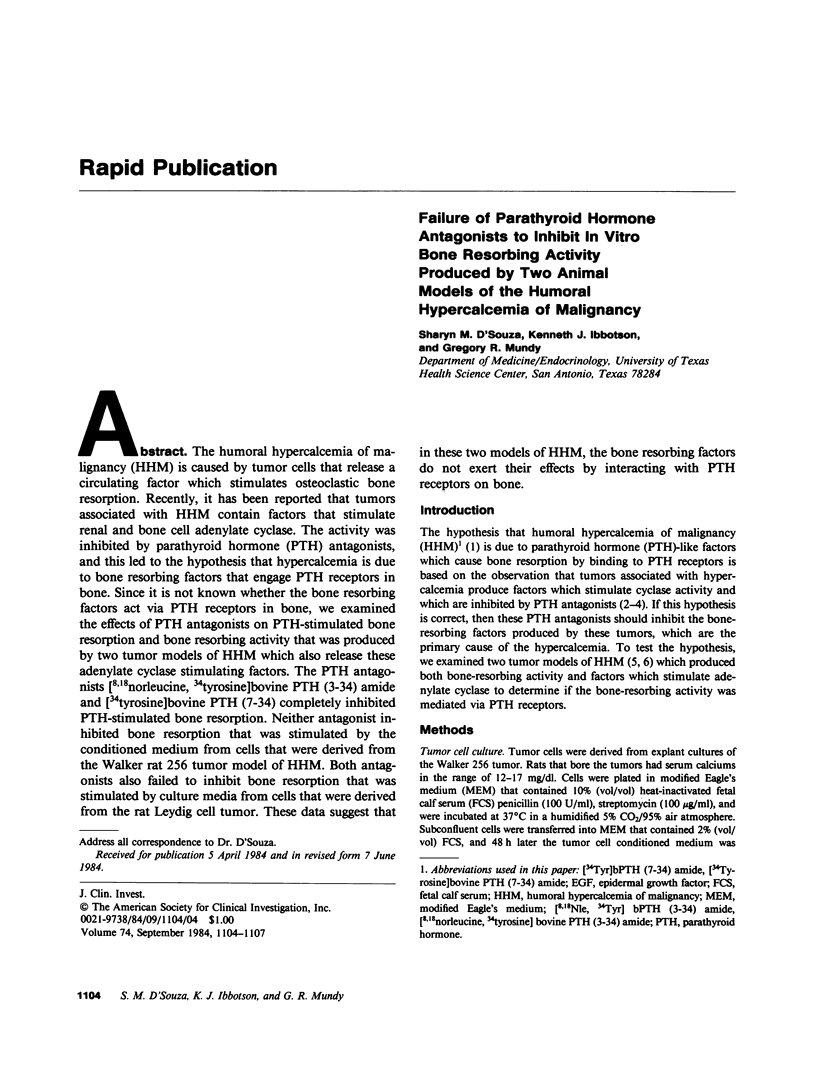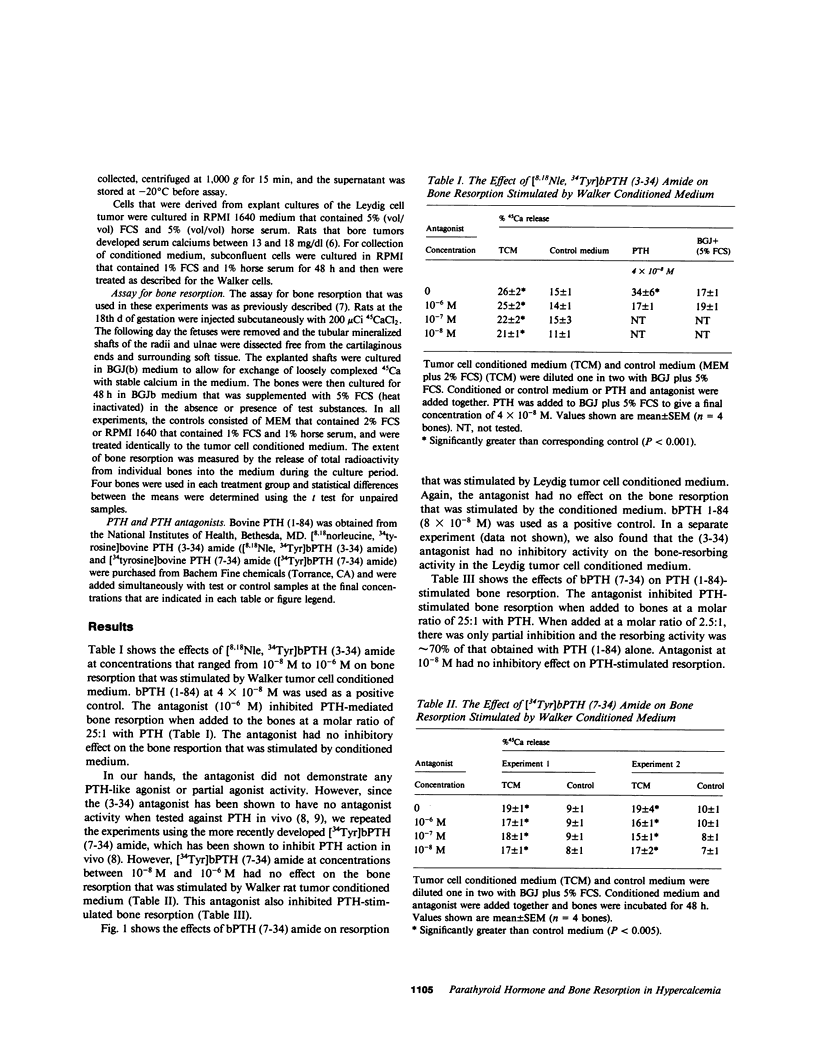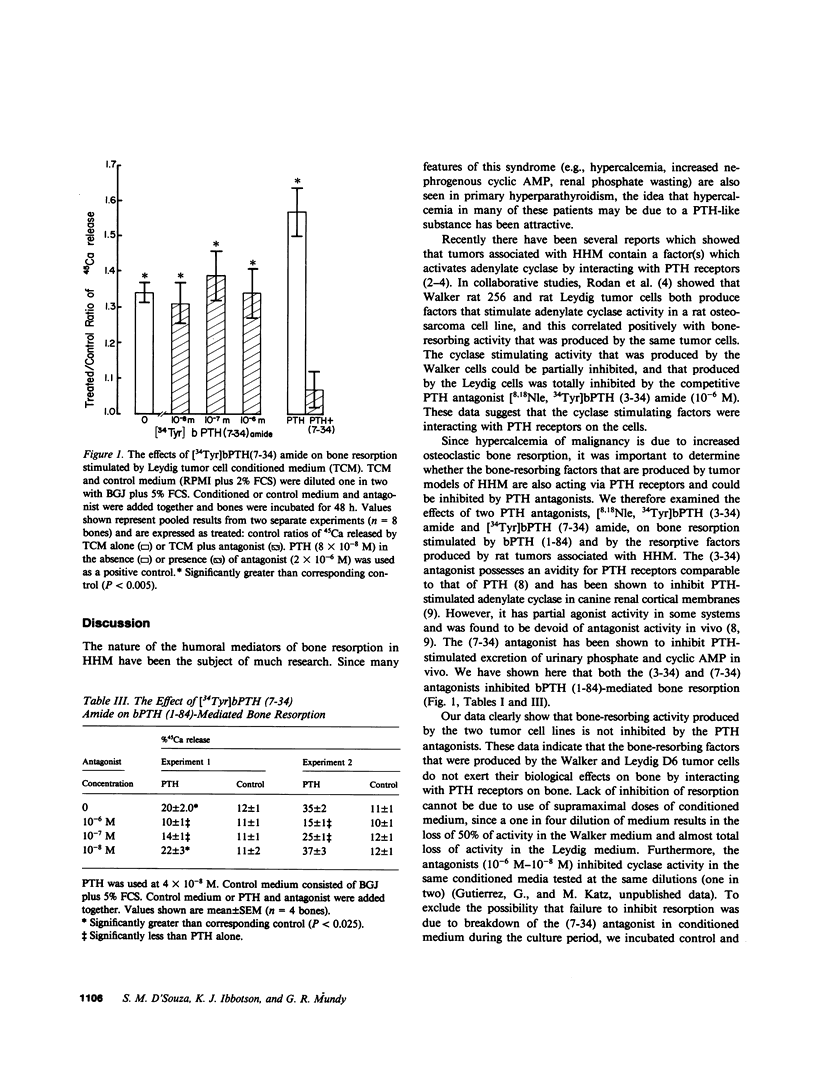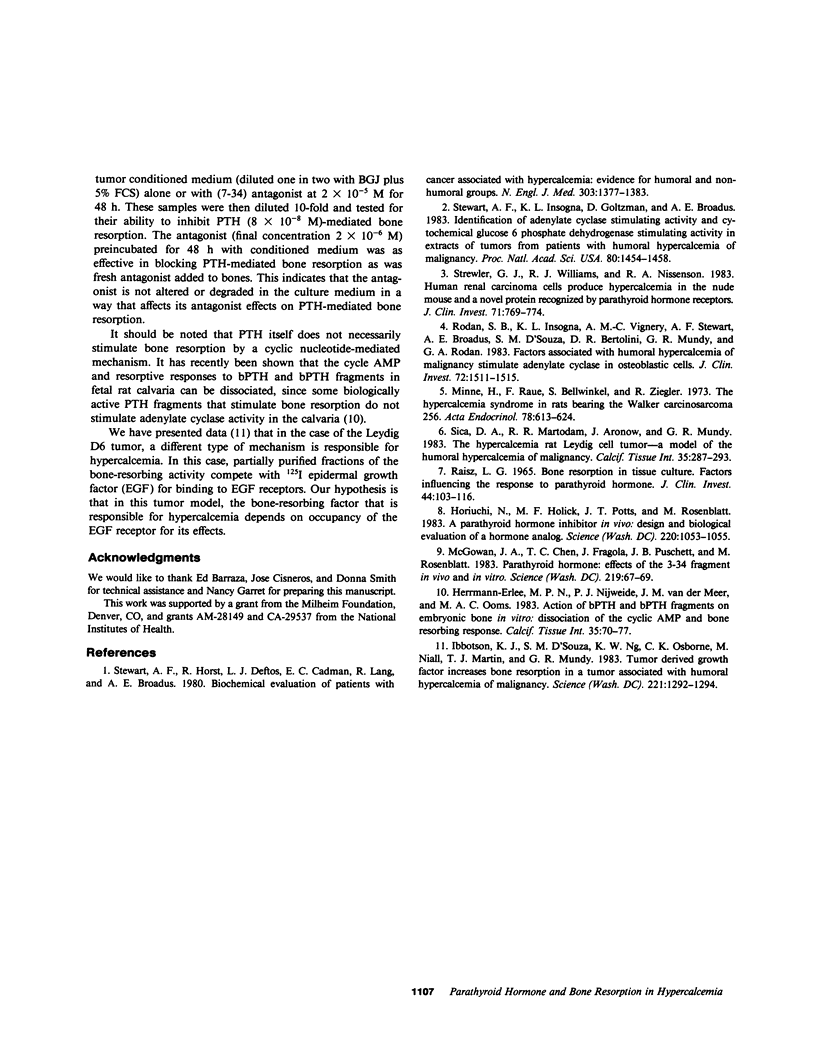Abstract
The humoral hypercalcemia of malignancy (HHM) is caused by tumor cells that release a circulating factor which stimulates osteoclastic bone resorption. Recently, it has been reported that tumors associated with HHM contain factors that stimulate renal and bone cell adenylate cyclase. The activity was inhibited by parathyroid hormone (PTH) antagonists, and this led to the hypothesis that hypercalcemia is due to bone resorbing factors that engage PTH receptors in bone. Since it is not known whether the bone resorbing factors act via PTH receptors in bone, we examined the effects of PTH antagonists on PTH-stimulated bone resorption and bone resorbing activity that was produced by two tumor models of HHM which also release these adenylate cyclase stimulating factors. The PTH antagonists [8,18norleucine, 34tyrosine]bovine PTH (3-34) amide and [34tyrosine]bovine PTH (7-34) completely inhibited PTH-stimulated bone resorption. Neither antagonist inhibited bone resorption that was stimulated by the conditioned medium from cells that were derived from the Walker rat 256 tumor model of HHM. Both antagonists also failed to inhibit bone resorption that was stimulated by culture media from cells that were derived from the rat Leydig cell tumor. These data suggest that in these two models of HHM, the bone resorbing factors do not exert their effects by interacting with PTH receptors on bone.
Full text
PDF



Selected References
These references are in PubMed. This may not be the complete list of references from this article.
- Herrmann-Erlee M. P., Nijweide P. J., van der Meer J. M., Ooms M. A. Action of bPTH and bPTH fragments on embryonic bone in vitro: dissociation of the cyclic AMP and bone resorbing response. Calcif Tissue Int. 1983;35(1):70–77. doi: 10.1007/BF02405009. [DOI] [PubMed] [Google Scholar]
- Horiuchi N., Holick M. F., Potts J. T., Jr, Rosenblatt M. A parathyroid hormone inhibitor in vivo: design and biological evaluation of a hormone analog. Science. 1983 Jun 3;220(4601):1053–1055. doi: 10.1126/science.6302844. [DOI] [PubMed] [Google Scholar]
- Ibbotson K. J., D'Souza S. M., Ng K. W., Osborne C. K., Niall M., Martin T. J., Mundy G. R. Tumor-derived growth factor increases bone resorption in a tumor associated with humoral hypercalcemia of malignancy. Science. 1983 Sep 23;221(4617):1292–1294. doi: 10.1126/science.6577602. [DOI] [PubMed] [Google Scholar]
- McGowan J. A., Chen T. C., Fragola J., Puschett J. B., Rosenblatt M. Parathyroid hormone: effects of the 3-34 fragment in vivo and vitro. Science. 1983 Jan 7;219(4580):67–69. doi: 10.1126/science.6849118. [DOI] [PubMed] [Google Scholar]
- Minne H., Raue F., Bellwinkel S., Ziegler R. The hypercalcaemic syndrome in rats bearing the Walker carcinosarcoma 256. Acta Endocrinol (Copenh) 1975 Mar;78(3):613–624. doi: 10.1530/acta.0.0780613. [DOI] [PubMed] [Google Scholar]
- RAISZ L. G. BONE RESORPTION IN TISSUE CULTURE. FACTORS INFLUENCING THE RESPONSE TO PARATHYROID HORMONE. J Clin Invest. 1965 Jan;44:103–116. doi: 10.1172/JCI105117. [DOI] [PMC free article] [PubMed] [Google Scholar]
- Rodan S. B., Insogna K. L., Vignery A. M., Stewart A. F., Broadus A. E., D'Souza S. M., Bertolini D. R., Mundy G. R., Rodan G. A. Factors associated with humoral hypercalcemia of malignancy stimulate adenylate cyclase in osteoblastic cells. J Clin Invest. 1983 Oct;72(4):1511–1515. doi: 10.1172/JCI111108. [DOI] [PMC free article] [PubMed] [Google Scholar]
- Sica D. A., Martodam R. R., Aronow J., Mundy G. R. The hypercalcemic rat Leydig cell tumor--a model of the humoral hypercalcemia of malignancy. Calcif Tissue Int. 1983 May;35(3):287–293. doi: 10.1007/BF02405048. [DOI] [PubMed] [Google Scholar]
- Stewart A. F., Horst R., Deftos L. J., Cadman E. C., Lang R., Broadus A. E. Biochemical evaluation of patients with cancer-associated hypercalcemia: evidence for humoral and nonhumoral groups. N Engl J Med. 1980 Dec 11;303(24):1377–1383. doi: 10.1056/NEJM198012113032401. [DOI] [PubMed] [Google Scholar]
- Stewart A. F., Insogna K. L., Goltzman D., Broadus A. E. Identification of adenylate cyclase-stimulating activity and cytochemical glucose-6-phosphate dehydrogenase-stimulating activity in extracts of tumors from patients with humoral hypercalcemia of malignancy. Proc Natl Acad Sci U S A. 1983 Mar;80(5):1454–1458. doi: 10.1073/pnas.80.5.1454. [DOI] [PMC free article] [PubMed] [Google Scholar]
- Strewler G. J., Williams R. D., Nissenson R. A. Human renal carcinoma cells produce hypercalcemia in the nude mouse and a novel protein recognized by parathyroid hormone receptors. J Clin Invest. 1983 Mar;71(3):769–774. doi: 10.1172/JCI110825. [DOI] [PMC free article] [PubMed] [Google Scholar]


